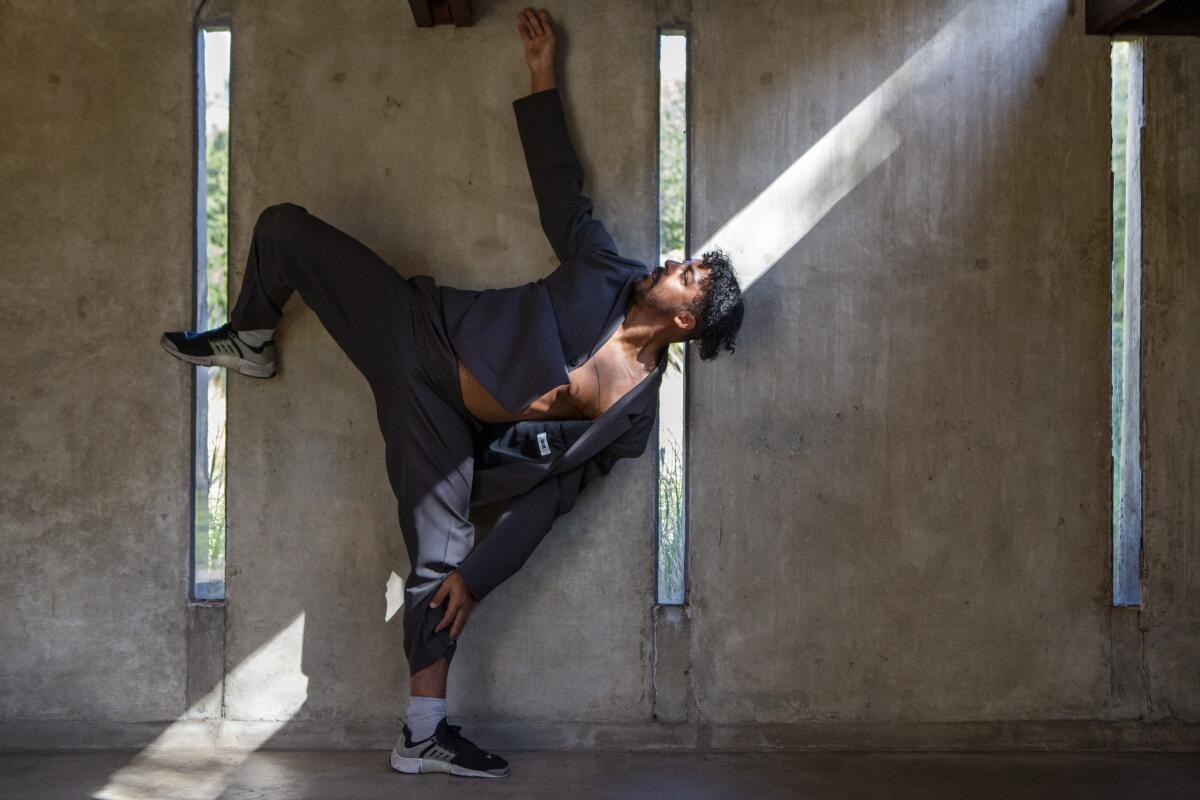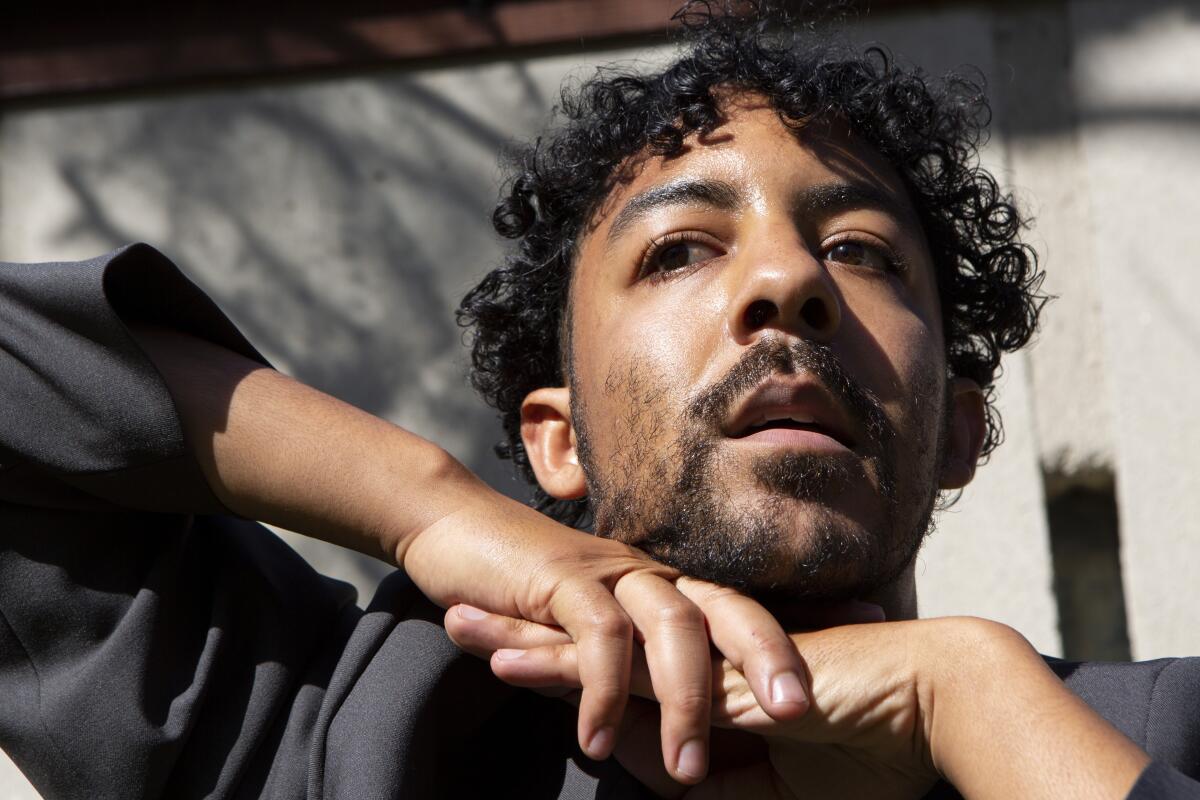Dance audiences are usually wealthy and white. Chris Emile aims to change that

Since returning to L.A. six years ago, choreographer Chris Emile has cultivated the type of supporters whom traditional dance companies desperately struggle to reach: young, hip, people of color.
Emile, 32, has appealed to communities beyond the cityâs white, wealthy dance lovers by setting his work in nontraditional dance spaces and by tackling race and other social issues.
After noticing that some art gallery openings attracted the type of people he wanted at his own shows, he âstarted approaching museums and art spaces rather than theaters because they had this audience of young people who were interested in art, but just might not have the background to know that they might be interested in dance,â Emile said.
The choreographer recently was preparing for his first solo exhibition and series of performances exploring black masculinity at the MAK Center for Art and Architecture.

âAmendâ follows the life of one man, from childhood through middle age, with a cast of three dancers. Audiences are guided through the modernist home of the late architect Rudolph Schindler, a space transformed through movement, archival footage, sculpture and sound.
The work began as a film project about masculinity with director Jackson Kroopf.
âWe both had similar experiences growing up, just feeling a bit strange in our bodies, specifically around masculinity and not really identifying with what it is to be masculine in society,â Emile said.
Last year USC invited Emile and other choreographers to search through their digital archives and propose a work. Emile was drawn to recordings about government policies including welfare work requirements and redlining â the 1930s federal housing policy that reinforced segregation by refusing to insure mortgages in black neighborhoods.
Emile used the clips to inform âAmend,â a work about âthis manâs life and all of the societal and governmental policies that have been put into place to show what a black man, specifically in Los Angeles, what his outcome is now.â
DIY choreography wasnât the dance career Emile imagined while growing up in Inglewood and obsessing over concert dance companies like Alvin Ailey American Dance Theater.
Emile began dancing with Lula Washington Dance Theatre. He trained with the Ailey School and Alonzo King Lines Balletâs program in San Francisco, honing the skills that eventually would make him a dancer on traditional stages.

âWhen youâre training, it seems more like a dream,â he said. âBut once you start working, itâs about ⌠being an empty vessel for whoeverâs in front of the room. And depending on the politics of the company, you might not get to really dance.â
Emile was dancing with Chicagoâs Luna Negra Dance Theater when the company abruptly closed in 2013.
About two years later, another major company, Cedar Lake Contemporary Ballet, shuttered. âI was just seeing the state of affairs of contemporary concert dance and just how it was really failing, and how nobody was really trying to engage the audience,â Emile said.

After moving back to L.A., he stopped dancing for companies and started creating his own work.
Emile co-founded the dance collective No)one. Art House with three other dance-makers in 2014. The goal was to bring concert-like dance to unconventional spaces in the city, âbecause I hadnât really seen that in Los Angeles and I hadnât seen black people doing it either,â Emile said.
âIt was really important for us to show people of color in our performances and just be physically closer to the audience, because we felt that was the way to get people impacted and get people involved in what we were doing.â
The group has staged works the Getty Center, the Museum of Contemporary Art and the California African American Museum, among other places. In 2016 the collective commissioned New York choreographer Danielle Russo to make work in a East L.A. photo studio.
They were surprised to find singer-songwriter and performance artist Solange in the audience of about 60 people.
Solange took immediate interest in No)one. Art House. She commissioned the collective to stage an immersive work through her creative agency, Saint Heron, in a West Adams artist loft in 2017. The show was a hit and Emile later wrote on Instagram, âI have never seen this many people of color attend a contemporary dance concert.â
Dancing for contemporary companies, âyou tour and you perform for all these people that you have no connection with,â Emile said. âBut to know that people who come from the same community as me â my friends, my family â could come to my home and see what my company was doing, it was a huge moment for me.â
Since then, Emile has worked consistently at the intersection of contemporary and commercial dance, choreographing for the San Francisco Symphony and Institute of Contemporary Art, Los Angeles. Heâs also worked with genre-bending pop artists including Anderson .Paak, Kelela and Moses Sumney.
The goal is always finding new ways to merge audiences and create new dance lovers.
âDancers make dance for other dancers,â Emile said. âIt makes no sense, itâs very insular. [Iâm] just trying to get out of that and to allow people in and give them more access to what weâre doing so they donât feel like they have to read a book or take a million dance classes to know whatâs going on.â
Emile hopes to one day make a large-scale immersive work inspired by âSleep No More,â the successful immersive adaptation of Shakespeareâs âMacbethâ by British theater company Punchdrunk.
âItâs brilliant â the set design, theatricality, just everything is at such a high level and thereâs no reason why Los Angeles doesnât have that,â Emile said. âItâs a goal of mine to make something like that with my friends.â
'Amend' by Chris Emile
Where: Schindler House, 835 N. Kings Road, West Hollywood
When: 3:30, 4:30 and 5:30 p.m. March 7 and 21, April 11 and 25
Admission: Free
Info: makcenter.org
More to Read
The biggest entertainment stories
Get our big stories about Hollywood, film, television, music, arts, culture and more right in your inbox as soon as they publish.
You may occasionally receive promotional content from the Los Angeles Times.











